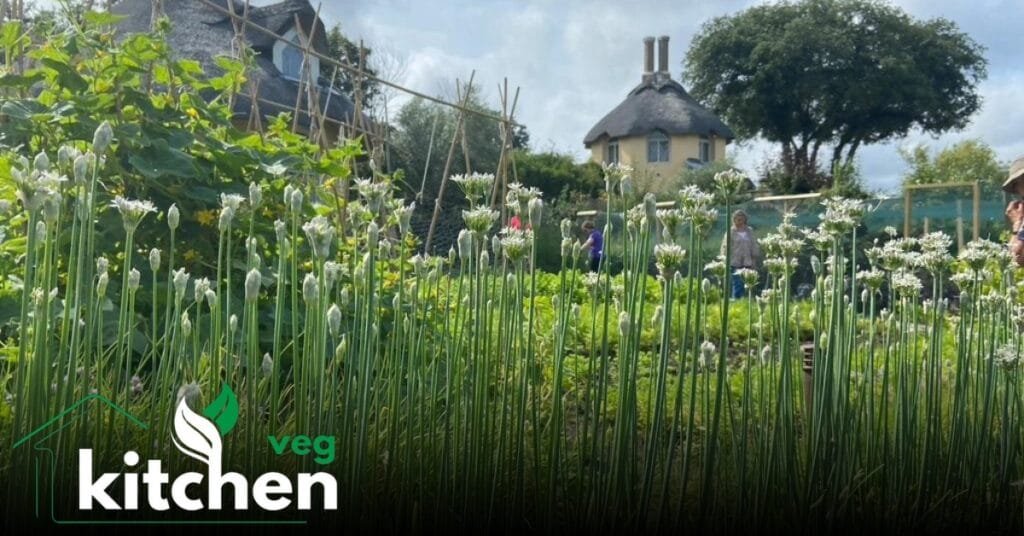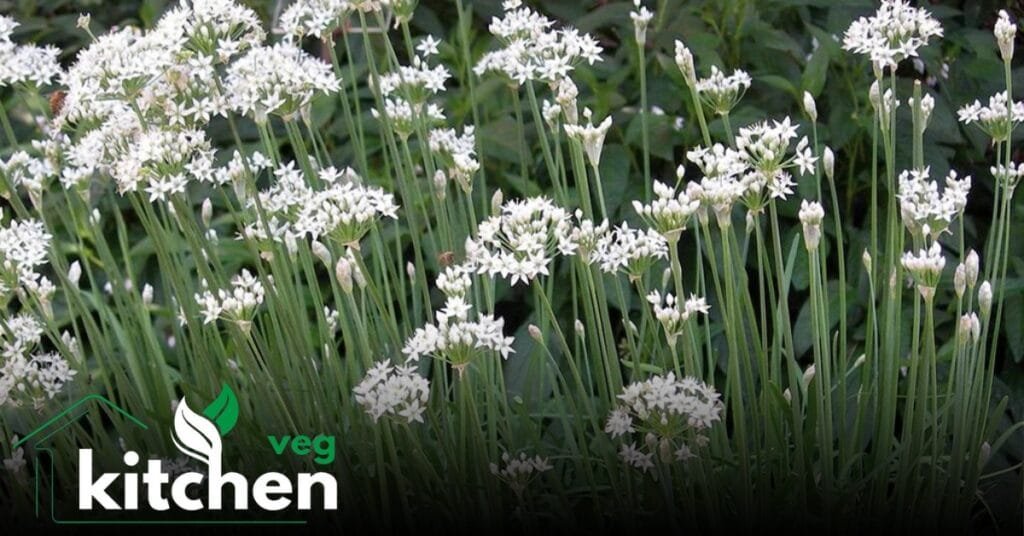Introduction
Garlic chives are a perennial herb in the Allium family known for their flat, grass-like leaves and white star-shaped flowers. Unlike regular chives (Allium schoenoprasum), which have a mild onion flavor, garlic chives have a distinct garlic taste.
They are frequently seen in Asian cooking, mainly Chinese, Korean, and Japanese recipes. Garlic-chives are not only prized for their culinary applications but also for their ornamental value in gardens.
History and Origin
Garlic chives have a long history, originating in the temperate regions of Asia, particularly in China and Mongolia. They have been cultivated for centuries and are mentioned in ancient Chinese texts as culinary and medicinal herbs. Over time, garlic-chives spread to other parts of Asia and eventually to Europe and North America, where they are now widely grown.
Botanical Description
Garlic chives are herbaceous perennials that grow in clumps. They have slender, flat leaves that reach 12-24 inches long.
The leaves are dark green and have a mild garlic aroma when crushed. Garlic-chives can grow up to thirty inches tall, and during the late summer and early autumn, they produce clusters of small, white, star-shaped blooms. The flowers are attractive and edible, adding a delicate garlic flavor to dishes.
Varieties of Garlic Chives
There are several varieties of garlic-chives, each with unique characteristics. The most common types include:
- Standard Garlic Chives (Allium tuberosum) are the most commonly grown variety. They have flat, broad leaves and white flowers.
- Chinese Yellow Chives (Allium tuberosum var. Ciu): Also known as golden chives, these are grown in the dark to produce pale yellow leaves. They have a milder flavor and are prevalent in Chinese cuisine.
- Korean Garlic Chives (Allium tuberosum var. Coreanum) have slightly thicker leaves and a more robust garlic flavor. They are often used in Korean dishes like kimchi and savory pancakes.
Growing Garlic Chives
Garlic chives may be grown in many different environments but are relatively simple. Here are the critical steps for successful cultivation:

Site Selection
Garlic chives prefer full sun but can tolerate partial shade. Pick a spot with lots of organic matter and well-drained soil.
Soil Preparation
Fertility and drainage are enhanced when the soil is prepared with compost or well-rotted manure. Garlic-chives thrive in slightly acidic to neutral soil (pH 6.0-7.0).
Planting
Garlic chives can be grown from seeds, transplants, or divisions. Once the last frost has passed, sow seeds immediately in the garden or begin inside 6–8 weeks beforehand. Space seeds or transplants 6-12 inches apart in rows 12-18 inches apart. If dividing established clumps, do so in early spring or fall.
Watering
Maintain a constant moisture content in the soil, particularly in arid spells. Water at the base of the plants to avoid wetting the leaves, which can lead to fungal diseases.
Fertilization
Regular feeding benefits garlic-chives. To encourage healthy growth, apply a balanced fertilizer in the spring and mid-summer.
Maintenance
Remove weeds regularly and mulch around the plants to retain moisture and suppress weed growth. If you prefer to harvest leaves, reduce the foliage to encourage new growth and prevent flowering.
Harvesting and Storage
Garlic chives are ready to be picked at 6 to 8 inches tall.Here’s how to harvest and store them:
Harvesting Leaves
Cut the leaves using scissors or a sharp knife, leaving 1-2 inches above the ground to promote regrowth. Harvest leaves regularly to encourage continuous production.
Harvesting Flowers
The flowers can be harvested just as they begin to open. Snip the flower stalks close to the base and use them fresh.
Storage
Fresh garlic-chives can be stored in a plastic bag or container in the refrigerator for up to a week. For long-term storage, chop the leaves and freeze them in airtight containers or bags.
Culinary Uses
Garlic chives are a versatile ingredient in the kitchen. Their mild garlic flavor complements a wide range of dishes. Here are some popular culinary uses:
Stir-Fries
Add chopped garlic-chives to stir-fries for a burst of flavor. They pair well with vegetables, meat, seafood, and tofu.
Dumplings and Pancakes
Garlic chives are a standard filling for dumplings and savory pancakes in Chinese and Korean cuisine.
Soups and Stews
Garlic chives add depth of flavor to soups and stews. They are trendy in Asian-style broths and noodle soups.
Salads
Chopped garlic chives make a great addition to salads, adding a mild garlic taste without overpowering other ingredients.
Garnishes
Garnish various dishes with garlic-chives to enhance flavor and presentation, including eggs, potatoes, and seafood.
Medicinal Benefits
Traditional medicine has utilized garlic chives due to their possible health advantages. Some of the medicinal properties include:
Antimicrobial Properties
Garlic chives contain antimicrobial compounds, promoting immune system growth and combating infections.
Digestive Aid
The herb is known to aid digestion and alleviate digestive disorders. It can stimulate appetite and reduce bloating and gas.
Antioxidant Effects
Antioxidants in garlic-chives help shield the body from oxidative stress and lower the risk of chronic illnesses.
Anti-inflammatory Properties
Garlic chives have anti-inflammatory chemicals that may help lessen inflammation and ease the symptoms of inflammatory diseases.
Nutrient-Rich
Garlic chives provide several health benefits, including being a high source of calcium, iron, and vitamins A and C.
Companion Planting
Garlic-chives make excellent companion plants in the garden due to their pest-repellent properties. They can help deter aphids, carrot flies, and other pests. Here are some superb companion plants for garlic-chives:
Carrots
Garlic chives can repel carrot flies, making them a beneficial companion for carrots.
Roses
Planting garlic chives near roses can help deter aphids and other pests that commonly affect roses.
Tomatoes
Garlic chives can enhance the growth and flavor of tomatoes while repelling pests like aphids and spider mites.
Grapes
Plant garlic-chives around grapevines to deter pests and improve grape yield.

Common Pests and Diseases
Garlic chives can be impacted by a few frequent problems even if they are relatively resistant to pests and diseases:
Onion Thrips
These tiny insects can damage the leaves, leading to silvery streaks and browning. To control thrips, use insecticidal soap or neem oil.
Fungal Diseases
Garlic chives can be susceptible to fungal diseases like downy mildew and rust. To prevent these issues, ensure proper spacing and good air circulation.
Root Rot
Garlic chives may get root rot due to poorly drained soil. To prevent this problem, plant in well-drained soil and avoid overwatering.
Conclusion
Garlic chives are a valuable addition to any garden and kitchen. Their unique garlic flavor, easy cultivation, and numerous health benefits make them a popular herb among gardeners and chefs.
Whether you’re growing them for their culinary uses, medicinal properties, or ornamental value, garlic chives will surely enhance your garden and culinary repertoire. Following this article’s guidelines, you can successfully grow, harvest, and enjoy garlic-chives in various dishes, improving your food’s taste and nutritional value.

